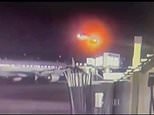The agonizing crucifixion of Jesus from the Bible details how he endured severe beatings, punctures and nails driven into his hands and feet.
Christians believe those wounds were miraculously imprinted on the burial shroud after Jesus was resurrected from the dead, scorched into the fibers by a burst of energy when he came back to life.
Now, a new analysis of the Shroud of Turin - also known as the Holy Shroud - claims to have uncovered evidence that the crucifixion may be historically accurate.
An engineer from the University of Padua in Italy used modern technology to reanalyze samples taken from the cloth in the 1970s, finding tiny blood particles showing signs of organ failure, trauma, disease and radiation.
Materials that were typical in ancient Jerusalem were also said to be discovered, suggesting that the shroud may have originated in the region and not in Europe where many skeptics think it was created as a medieval forgery.

Independent experts dismissed the findings, however, saying blood could have contaminated the cloth at any point in the past 700 years.
The Shroud of Turin is a 14-foot-long piece of linen featuring a faint image of the front and back of a man who Christians believe to be Jesus.
The cloth was first presented to the public in the 1350s, when it was exhibited in small collegiate church in Lirey, a village in northern France. Some believe it to be a Medieval fake.
It was not until 1978 when the first physical samples were removed from the cloth, done using adhesive tape to carefully lift particles from the front fibers and a vacuum to collect dust from the back.
But, back then, the results were inconclusive about whether or not blood had been present in the samples.
Now, University of Padua professor Giulio Fanti has placed those samples under modern-day microscopes capable of highlighting details down to the size of individual particles.
His study was published in Archives of Hematology Case Reports and Reviews, which peer-reviewed his research.
The reanalyzed particles showed the presence of hemoglobin, which is a key component of blood, and also two different types of blood that Fanti labeled Type A and Type B.
Fanti says this suggests the cloth was used on someone with bloody injuries, rather than forged using ink, dye, paint or other techniques.
Traces of creatine were also identified in the shroud sample, which is released into the blood stream when a person undergoes muscle breakdown or some type of trauma.
Your body produces creatine from amino acids in your liver, kidneys, and pancreas. It is also present in foods.
The body releases the chemical into the bloodstream when cells in the brain, heart or skeletal muscles are damaged.



'The high percentage of creatinine found in [the sticky tape samples], may be explained, especially during Jesus' last hour before dying on the cross, by a reduced blood flow to the kidneys also caused by hypovolemia and by severe dehydration,' the study reads.
Fanti claimed that his findings align with John 19:28 that states 'Jesus said, I thirst.'
The samples also featured signs the person whose blood allegedly stained the shroud had suffered from uremic syndrome which occurs when the kidneys are unable to eliminate waste products.
While the condition typically happens from kidney disease, it can also be brought on by blunt trauma to the organ, which Fanti believes may have occurred when Jesus was whipped.
John 12:1 reads, 'Then Pilate took Jesus and had him flogged.'
'I would refer to Type A blood as that which came out of the corpse and therefore postmortem blood; it consists of microcytes which indicate the respiratory suffering of Jesus on the cross,' Fanti, a Christian who has been studying the shroud for 25 years, told DailyMail.com.
While the testing cannot prove whose blood litters the cloth, a new recent study claimed to find evidence that the shroud dates back 2,000 years.
This new finding came in stark contrast to a 1988 study which found the shroud to be a fake, after researchers determined it had been produced between 1260 and 1390 AD.


In his study, Fanti found the blood particles he labled 'Type B' to mostly have a darker color than the 'Type A' blood and sharper edges.
He claims this suggests Type B came from before Jesus had died, with the differences being due to clotting characteristics.
'Type B consists of coagulated blood crusts probably formed when Jesus was on the cross or ascended Calvary,' said Fanti.
Both types of blood also had traces of earth materials that Fanti said are typically found in Jerusalem, such as clay and limestone, suggesting that the shroud may have originated in the region.
Mark 15:46 explains how Joseph, one of Jesus' disciples, removed Christ from the cross and 'bought a linen shroud, and taking him down, wrapped him in the linen shroud and laid him in a tomb that had been cut out of the rock.'
Some believe that Jesus' body was not washed during that time, but quickly placed in the tomb, which means he was not cleaned of earthy materials before being wrapped.
'When I went to Jerusalem to analyze the earthy material taken from the Holy Shroud, geologist Amir Sandler of the Geological Survey Of Jerusalem recognized among other things, like smectite and illite, which are typical of the Jerusalem soil as well as other material coming from the Sahara winds,' Fanti explained.
The blood detected by Fanti was also said to have evidence of possible radiation in different forms.
The Type A blood contained Beta particles that are electrons of great kinetic energy emitted by some radioactive nuclei, such as Potassium-40 used in explosives and fireworks.
Photon radiation particles were identified in the Type B samples - these are also known as Gamma rays, which are typically formed by a nuclear reaction.
However, Dr Lawrence Kobilinsky, a forensic scientist who is a professor emeritus at John Jay College, told DailyMail.com that the 'blood' was likely a 'secondary thought.'
'Earlier work... found a pigment [coloring agent] constituted the image,' he said.
Indeed, American chemist Dr Walter McCrone, who analyzed the tape strips in 1978, found the image consisted of red ochre and a gelatin solution.
'The simplest explanation is that this shroud was placed over a statue covered with pigment in certain areas, which transferred to the cloth, and gave it this three-dimensional configuration when you do the right kind of photography,' Dr Kobilinsky said.



A study in 2018 also determined the shroud to be a fake after a new forensic investigation showed that its bloodstains were left by someone who had been standing – rather than crucified.
Researchers concluded that the bloodstain patterns were also not consistent with a face-down corpse.
Dr Matteo Borrini, a forensic scientist at Liverpool John Moores University, worked with chemist Luigi Garlaschelli, of the University of Pavia in Italy, looking at the orientation of the shroud's stains.
They sought to answer whether the crucifixion shown on the shroud was T-shaped, Y-shaped, or revealed another type of ancient Roman execution.
What they found, however, was that the bloodstains were not consistent with any one pose in particular. This suggested that someone who had been standing was used to imprint the famous patterns at different angles for the hands, chest and back.
Christians have claimed the imprints were created by energy released from Christ's body at the moment of resurrection.












